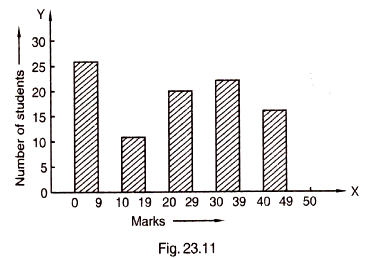Given below (Fig. 23.11) is the bar graph indicating the marks obtained out of 50 in mathematics paper by 100 students. Read the bar graph and answer the following questions:

(i) It is decided to distribute work books on mathematics to the students obtaining less than 20 marks, giving one work book to each of such students. If a work book costs Rs. 5, what sum is required to buy the work books?
(ii) Every student belonging to the highest mark group is entitled to get a prize of Rs. 10. How much amount of money is required for distributing the prize money?
(iii) Every student belonging to the lowest mark-group has to solve 5 problems per day. How many problems, in all, will be solved by the students of this group per day?
(iv) State whether true or False:
(a) 17% students have obtained marks ranging from 40 to 40.
(b) 59 students have obtained marks ranging from 10 to 29.
(v) What is the number of students getting less than 20 marks?
(vi) What is the number of students getting more than 29 marks?
(vii) What is the number of students getting marks between 9 and 40?
(viii) What is the number of belonging to the highest mark group?
(ix) What is the number of students obtaining more than 19 marks?
(i) Total numbers of students obtaining less than 20 marks = 27+ 12
= 39
The cost of one work book = Rs 5
Therefore, cash of 39 workbooks = 39 × 5
= Rs.195
(ii) The number of students belonging to the highest mark group = 17
The cost of a prize = 10
Therefore, cost of 17 prize
= 10 × 17
= Rs170
(iii) The number of students belonging to the lowest mark group = 27
The number of problems solved by 15 students = 5
Therefore, the total number of problems solved by 27 students = 5 × 27
= 135
(iv) (a)The total number of students = 100
The number of students in range 40-49, = 17
% of students marks ranging 40-49 = ![]() × 100
× 100
= 17%
So, the given statement is true.
(b) The number of students in range 10-29 = 32
% of students marks ranging 10-29 = ![]() × 100
× 100
= 32%
So the given statement is false.
(v) No, of students getting less than 20 marks = 39
(vi) Total number of students getting more than 29 marks = 41
(vii) Number of students getting marks between 9 and 40 = 12 + 20 + 24
= 56
(viii) The number of students belonging to the highest mark group = 17
(ix) The number of students obtaining more than 19 marks = 100 - 27 - 12
= 61